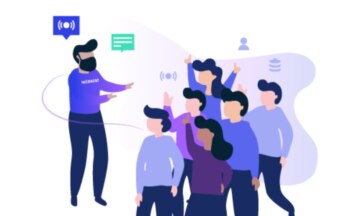The Everything Experience Comes to Marketing

Prospects, leads and customers want everything. They want all the relevant information you can provide them. They want your attention. They want the best deals possible. They want your commitment. They want this every time they interact with your organization. What they want, what they expect, is the everything experience.
Like Amazon’s claim to be “the everything store,” B2B marketers need to provide “the everything experience,” to audiences at every stage of the buying cycle. Marketers need to develop, consolidate, personalize and publish a comprehensive experience encapsulating all the relevant content from first-touch and close-won to retention and upsell. And marketers need to do it at scale for nearly every customer.
To their credit, marketing teams are organizing to provide “everything” experiences. But there are a few problems they need to tackle first. They need to know what goes into an everything experience, how an experience works and, finally, how to scale that experience to the variety of markets it needs to address.
The Elements of Everything
First, organizations need to start with the basics. This includes personas, a map to your buyer’s journey and a keen understanding of what content you have. Marketers should also know what resonates with audiences and where within the buyer’s journey that content is most relevant.
Once these elements are mapped out, marketers ought to fill in any content gaps in their buyer’s journey. Prioritize material that scale easily, like case studies, ebooks and blog posts. After that, look for opportunities to craft intimate messages, like videos and podcasts, that address a company’s specific pain point or stage of the buyer’s journey.
Making The Everything Experience Work
Okay, so let’s say you have most, if not all, of the content you need to address your buyer’s journey. First: congrats — you have everything it takes to create an everything experience. All you have to do now is put the parts in the right order and present them with the help of content hubs. Here, digital tools — like ON24 Target or ON24 Engagement Hub — can help simplify the creation of an experience through standardization and scale.
Assuming you’re using a digital tool, you’ll want to create different content hubs — the centerpieces of each experience. For example, you can create several content hubs that map to a typical buyer’s journey — top, middle, bottom (or awareness, consideration and decision) as well as a hub that helps new customers to onboard, or make use of, your solution. Combined, these hubs provide the everything experience.
Once these hubs are outlined, it’s time to map your content to them. However. There are three elements you’ll want to emphasize: interactivity, two-way communication and personalization. Don’t worry, these aren’t complicated concepts.
Interactivity simply means providing opportunities for visitors to click, download and otherwise interact with content. This can be as simple as providing a report to download or as complex as providing an on-demand webinar with additional content to interact with.
Two-way communication is any dialogue where you ask a question and the audience provides feedback — or vice versa. Polls, surveys, feedback prompts, on-demand webinars and “contact us” buttons are some great examples where you can dialogue with your audience.
Finally, personalize it. Hubs targeting a specific account, for example, should have personalized welcomes and content addressed to the account (even if it’s only in the title). Introduction videos, ones showing visitors how to interact with the hub, where relevant items are and how they can reach your team, are a great way to add a personal touch to your hubs as well.
Providing Everything at Scale
Alright. So you have your content, you have your hubs. You have, in essence, the everything experience in place. There’s just one thing left to do: scale it up to address a growing roster of accounts and industries.
Once you’ve got one in place, duplicate content experiences for different audiences is easy. Tweak your messaging, adjust your content and suddenly you’ve created an account-based marketing campaign.
And as you iterate, you can also assess. Specialized digital content hubs — like ON24 Target and ON24 Engagement Hub — are useful tools for content creators. Here’s why: they show who interacted with what content and how often. With this data, you can identify what connects, what doesn’t, who’s most interested in your services.
The best part is that you can continue to make this assessment over time. Depending on how you deploy your everything experiences, you can even A/B test titles, headlines and additional content to learn what you need more of, how you can make your hubs more interactive and provide the perfect everything experience every time.
Consumers have enjoyed the everything experience for a long time. B2B buyers, consumers themselves, are starting to expect the same treatment. Being able to adapt to these demands means taking the content you have and serving it up differently. It means thinking just as much about the delivery of your content as the creation of it. The everything experience is everything marketing should be — providing audiences a seamless, unlimited way to engage with your brand. The leads will follow.
